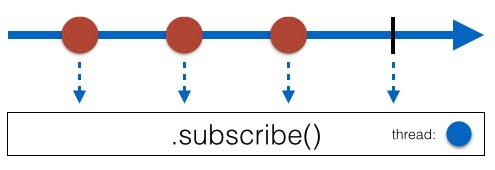理解 RxJava 的线程模型(上)
Posted 新东网技术发布
tags:
篇首语:本文由小常识网(cha138.com)小编为大家整理,主要介绍了理解 RxJava 的线程模型(上)相关的知识,希望对你有一定的参考价值。
来源:鸟窝(@colobu )
链接:colobu.com/2016/07/25/understanding-rxjava-thread-model/
目录
第一个例子,性能超好?
加上业务的模拟,性能超差
加上调度器,不起作用?
RxJava的线程模型
Schedulers
改造,异步执行
另一种解决方案
总结
参考文档
ReactiveX是Reactive Extensions的缩写,一般简写为Rx,最初是LINQ的一个扩展,由微软的架构师Erik Meijer领导的团队开发,在2012年11月开源。
Rx是一个编程模型,目标是提供一致的编程接口,帮助开发者更方便的处理异步数据流,Rx库支持.NET、javascript和C++,Rx近几年越来越流行了,现在已经支持几乎全部的流行编程语言了,Rx的大部分语言库由ReactiveX这个组织负责维护,比较流行的有RxJava/RxJS/Rx.NET,社区网站是 reactivex.io。
Netflix参考微软的Reactive Extensions创建了Java的实现RxJava,主要是为了简化服务器端的并发。2013年二月份,Ben Christensen 和 Jafar Husain发在Netflix技术博客的一篇文章第一次向世界展示了RxJava。
RxJava也在android开发中得到广泛的应用。
ReactiveX
An API for asynchronous programming with observable streams.
A combination of the best ideas from the Observer pattern, the Iterator pattern, and functional programming.
虽然RxJava是为异步编程实现的库,但是如果不清楚它的使用,或者错误地使用了它的线程调度,反而不能很好的利用它的异步编程提到系统的处理速度。本文通过实例演示错误的RxJava的使用,解释RxJava的线程调度模型,主要介绍Scheduler、observeOn和subscribeOn的使用。
本文中的例子以并发发送http request请求为基础,通过性能检验RxJava的线程调度。
一、第一个例子,性能超好?
我们首先看第一个例子:
public static void testRxJavaWithoutBlocking(int count) throws Exception {
CountDownLatch finishedLatch = new CountDownLatch(1);
long t = System.nanoTime();
Observable.range(0, count).map(i -> {
//System.out.println("A:" + Thread.currentThread().getName());
return 200;
}).subscribe(statusCode -> {
//System.out.println("B:" + Thread.currentThread().getName());
}, error -> {
}, () -> {
finishedLatch.countDown();
});
finishedLatch.await();
t = (System.nanoTime() - t) / 1000000; //ms
System.out.println("RxJavaWithoutBlocking TPS: " + count * 1000 / t);
}
这个例子是一个基本的RxJava的使用,利用Range创建一个Observable, subscriber处理接收的数据。因为整个逻辑没有阻塞,程序运行起来很快,
输出结果为:
RxJavaWithoutBlocking TPS: 7692307 。
二 、加上业务的模拟,性能超差
上面的例子是一个理想化的程序,没雨任何阻塞。我们模拟一下实际的应用,加上业务处理。
业务逻辑是发送一个http的请求,httpserver是一个模拟器,针对每个请求有30毫秒的延迟。subscriber统计请求结果:
public static void testRxJavaWithBlocking(int count) throws Exception {
URL url = new URL("http://127.0.0.1:8999/");
CountDownLatch finishedLatch = new CountDownLatch(1);
long t = System.nanoTime();
Observable.range(0, count).map(i -> {
try {
HttpURLConnection conn = (HttpURLConnection) url.openConnection();
conn.setRequestMethod("GET");
int responseCode = conn.getResponseCode();
BufferedReader in = new BufferedReader(new InputStreamReader(conn.getInputStream()));
String inputLine;
while ((inputLine = in.readLine()) != null) {
//response.append(inputLine);
}
in.close();
return responseCode;
} catch (Exception ex) {
return -1;
}
}).subscribe(statusCode -> {
}, error -> {
}, () -> {
finishedLatch.countDown();
});
finishedLatch.await();
t = (System.nanoTime() - t) / 1000000; //ms
System.out.println("RxJavaWithBlocking TPS: " + count * 1000 / t);
}
运行结果如下:
RxJavaWithBlocking TPS: 29。
@#¥%%……&!
性能怎么突降呢,第一个例子看起来性能超好啊,http server只增加了一个30毫秒的延迟,导致这个方法每秒只能处理29个请求。
如果我们估算一下, 29*30= 870 毫秒,大约1秒,正好和单个线程发送处理所有的请求的TPS差不多。
后面我们也会看到,实际的确是一个线程处理的,你可以在代码中加入
三、加上调度器,不起作用?
如果你对subscribeOn和observeOn方法有些印象的话,可能会尝试使用调度器去解决:
public static void testRxJavaWithBlocking(int count) throws Exception {
URL url = new URL("http://127.0.0.1:8999/");
CountDownLatch finishedLatch = new CountDownLatch(1);
long t = System.nanoTime();
Observable.range(0, count).map(i -> {
try {
HttpURLConnection conn = (HttpURLConnection) url.openConnection();
conn.setRequestMethod("GET");
int responseCode = conn.getResponseCode();
BufferedReader in = new BufferedReader(new InputStreamReader(conn.getInputStream()));
String inputLine;
while ((inputLine = in.readLine()) != null) {
//response.append(inputLine);
}
in.close();
return responseCode;
} catch (Exception ex) {
return -1;
}
}).subscribeOn(Schedulers.io()).observeOn(Schedulers.computation()).subscribe(statusCode -> {
}, error -> {
}, () -> {
finishedLatch.countDown();
});
finishedLatch.await();
t = (System.nanoTime() - t) / 1000000; //ms
System.out.println("RxJavaWithBlocking TPS: " + count * 1000 / t);
}
加上.subscribeOn(Schedulers.io()).observeOn(Schedulers.computation())看一下性能:
RxJavaWithBlocking TPS: 30。
性能没有改观,是时候了解一下RxJava线程调度的问题了。
四、RxJava的线程模型
首先,依照Observable Contract, onNext是顺序执行的,不会同时由多个线程并发执行。
图片来自 http://tomstechnicalblog.blogspot.com/2016/02/rxjava-understanding-observeon-and.html
默认情况下,它是在调用subscribe方法的那个线程中执行的。如第一个例子和第二个例子,Rx的操作和消息接收处理都是在同一个线程中执行的。一旦由阻塞,比如第二个例子,久会导致这个线程被阻塞,吞吐量下降。

图片来自 https://medium.com/@diolor/observe-in-the-correct-thread-1939bb9bb9d2
但是subscribeOn可以改变Observable的运行线程。

图片来自 https://medium.com/@diolor/observe-in-the-correct-thread-1939bb9bb9d2
上图中可以看到,如果你使用了subscribeOn方法,则Rx的运行将会切换到另外的线程上,而不是默认的调用线程。
需要注意的是,如果在Observable链中调用了多个subscribeOn方法,无论调用点在哪里,Observable链只会使用第一个subscribeOn指定的调度器,正所谓”一见倾情”。
但是onNext还是顺序执行的,所以第二个例子的性能依然低下。
observeOn可以中途改变Observable链的线程。前面说了,subscribeOn方法改变的源Observable的整个的运行线程,要想中途切换线程,就需要observeOn方法。
图片来自 http://tomstechnicalblog.blogspot.com/2016/02/rxjava-understanding-observeon-and.html
官方的一个简略晦涩的解释如下:
The SubscribeOn operator changes this behavior by specifying a different Scheduler on which the Observable should operate. The ObserveOn operator specifies a different Scheduler that the Observable will use to send notifications to its observers.
一图胜千言:
图片来自 http://reactivex.io
注意箭头的颜色和横轴的颜色,不同的颜色代表不同的线程。
来源:安卓应用频道
以上是关于理解 RxJava 的线程模型(上)的主要内容,如果未能解决你的问题,请参考以下文章